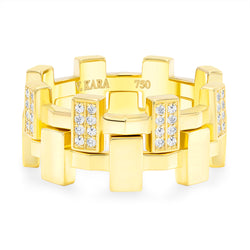Buying jewelry online can be a thrilling experience filled with endless possibilities, from discovering unique designs to getting great deals. However, it’s important to approach online jewelry shopping with a discerning eye, as it can be easy to overlook certain factors that could lead to a disappointing purchase. To help you make the right choice, here are the key things to consider when shopping for jewelry online.
1. Choose a Reputable Retailer
The first step in any online jewelry purchase is finding a trustworthy seller. Check for established brands or sellers with a good track record. Look for customer reviews, testimonials, and ratings on platforms like Google, Trustpilot, or social media to gauge the retailer's reputation. You should also verify the store’s return policy, contact information, and customer service options. A reputable retailer will provide clear details on their products and offer support if you have questions.
2. Know Your Materials and Stones
Understanding the materials and gemstones used in the piece is crucial. Whether you're buying gold, silver, platinum, or pieces featuring diamonds or other gemstones, it's essential to know exactly what you're getting. Look for information on the metal's purity (e.g., 14k, 18k gold) and the grading of gemstones. The four Cs of diamonds (cut, color, clarity, and carat weight) should always be clearly stated for pieces containing diamonds. For other gemstones, you may want to research their specific qualities and what affects their value.
3. Check for Certifications
Reputable jewelers will often provide certification from authoritative bodies such as the Gemological Institute of America (GIA) or the American Gem Society (AGS). Certification is especially important for high-value pieces as it ensures the authenticity of the materials and stones. A certified piece comes with a detailed report on the quality and characteristics of the gemstone, giving you peace of mind when making your investment.
4. Read the Fine Print on Return and Exchange Policies
One of the potential downsides of buying jewelry online is not being able to try on the piece before purchasing it. That’s why it’s essential to thoroughly read the return and exchange policies. Ensure the retailer offers a reasonable period for returns and that you won’t be stuck with a piece if it doesn’t meet your expectations. Look for any restocking fees or conditions on custom orders as well.
5. Understand the Sizing
When shopping for rings, bracelets, or necklaces, sizing is crucial. Make sure the retailer provides sizing charts and guidance on how to measure yourself correctly. Some stores may also offer adjustable pieces or resizing services. When in doubt, consult with customer service to ensure you're selecting the right size. Remember that resizing can be difficult for some designs, particularly intricate pieces or those with gemstone settings.
6. Secure Payment Options
Always prioritize websites that offer secure payment options, such as credit cards, PayPal, or other trusted payment gateways. Be cautious of sites that ask for unconventional payment methods like wire transfers or cryptocurrency, especially if they do not have a well-established reputation. Secure websites should also have "https" in the URL, indicating that your information will be encrypted.
7. Compare Prices
The beauty of online shopping is the ease with which you can compare prices across different retailers. However, be mindful that sometimes prices that seem too good to be true may indicate poor quality or even counterfeit products. Be sure to compare like-for-like products, considering factors such as metal purity, stone quality, and craftsmanship. Also, factor in any additional costs like shipping or customs duties if you’re purchasing from international sellers.
8. Consider Customization Options
Many online jewelers offer customization, allowing you to choose specific gemstones, metal types, or engraving options. This can be a great way to create a personalized piece that is unique to you or your loved one. If customization is a priority, check the lead time and be clear on the retailer’s return policy for bespoke items, as these are often non-refundable.
9. Study the Images and Descriptions
Since you can’t see the piece in person, carefully scrutinize the product images and descriptions. Look for clear, high-resolution images that show the jewelry from multiple angles. The description should detail all aspects of the piece, including dimensions, weight, materials, and any special features. If the photos are vague or the description is lacking, you may want to ask the retailer for more information before committing to a purchase.
10. Customer Support
Good customer service is vital for a smooth online shopping experience. Whether you need help choosing a piece or have questions about your order, the retailer should be responsive and willing to assist. Look for retailers that offer chat support, email, or phone assistance, especially if you’re making a high-value purchase.
Shopping for jewelry online offers the opportunity to find beautiful, unique pieces from the comfort of your own home. By taking the time to research the retailer, understand the product details, and prioritize secure shopping practices, you can ensure a satisfying and rewarding purchase. Whether you’re buying for yourself or a loved one, following these guidelines will help you make an informed decision and invest in a piece of jewelry that you’ll treasure for years to come.



Leave a comment